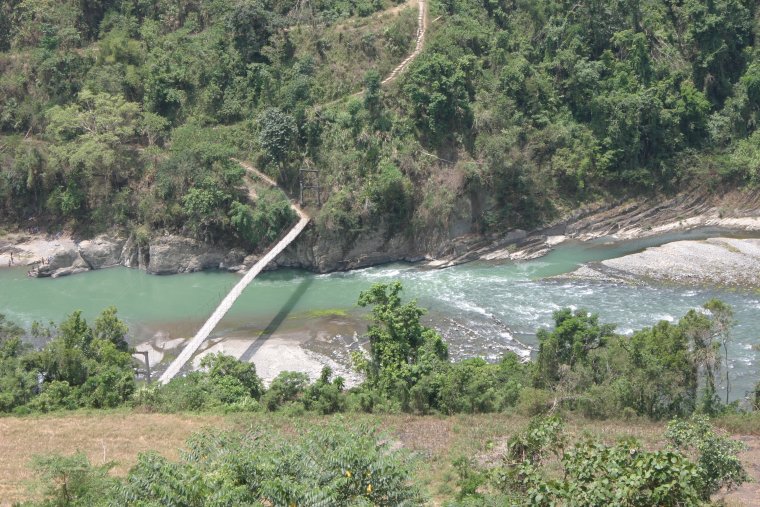Easter 2011
During our Easter vacation in 2011, which brought us surfing in Baler and a very adventurous ride to the Mountain Province, we passed by Kalinga Province. to investigate the Chico river. According to Chico River Quest, the biggest white water rafting tour operator in Kalinga, the water level was not suitable for rafting that time as it was dry season. We went to take a look at it anyway with the hope that some sections would have sufficient water for our lightweight Gumotex Palava canoe and Gumotex Traveller kayak. Afterall, we are looking for a maximum of only water level III as this is going to be a first for both the kayak and its rider – the maiden vogage of the Traveller and Miriam’s first “solo” white water try (she’s paddled solo at age 10 on Daniel’s self-made boat along the quiet Regen river in Germany).
Chico River is a river in Kalinga province with some history. The former president Marcos wanted to build a dam to produce 1,000 megawatts of elecricity but the Cordillera people prevented it partly with armed resistance. Nowadays it is safe in terms of peace and order but the river itself can be very wild, especially during the rainy season. Chico River Quest organizes commercial rafting tours on inflatable rafts when the river has sufficient water, usually not in the dry season.
Preparations
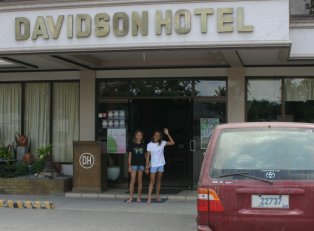
We used Davidson Hotel in Tabuk as our base and took the first day gathering information and doing an occular inspection. The staff in the hotel called the rafting operators and got the information that there was not enough water but that we can give the river a try with our own boats.
On the way back we explored 3 points with road access to the river and got landmarks that can be seen from the river in case we would need to abort due to whatever reason. Since we did not have a detailed map, I named them: “Lumber village”, because of the wooden logs that were moved across the river at this point; “Rocky road”, for a section of the road that runs just next to the river and is carved out of the rock; and “Caterpillar”, for a construction site at the lake created by an irrigation dam.
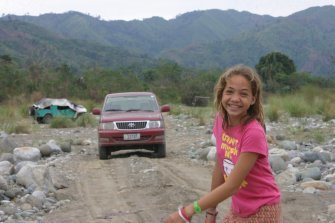
Driving distance between Lumber village and Rocky raod is around 8km and Caterpilar is around 2 km further downstream.
Since the next days would be the Easter holidays we spent a few hours on shopping for some supplies and also for duct tape, following Miles statement in Lost: “I don’t believe in many things but I do believe in duct tape.”
Canoeing Chico
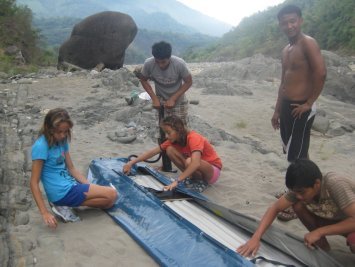
The friendly staff of Davidson Hotel helped us look for transport that will bring us to Barangay Naning, our chosen launch spot and pick us up in either of the 3 access points downstream. The driver that showed up owns a mini truck that was perfect for our gear and the rough roads.
The driver would wait for us at the “Lumber village” in case we experience problems or already had enough. I still had a torn muscle in my back from trying to get on a surfboard two days earlier in Baler, so this could prove to be a problem. Otherwise, we proceed to “Rocky Road”.
It was Easter and therefore there were a lot of village people in Naning, a lot more than the previous day. Some of them helped to carry the gear down to the river and to inflate the boats. Others gave advice or commented expertly on our two boats. Half of the village population seemed to have gathered at the river bank to see us off.
I advised the kids to wear their wet suits for protection, in case they had to swim since the river bed has a lot of huge boulders. We launched around 9:00 am, one of the villagers said we would be at the lake at around 16:00.
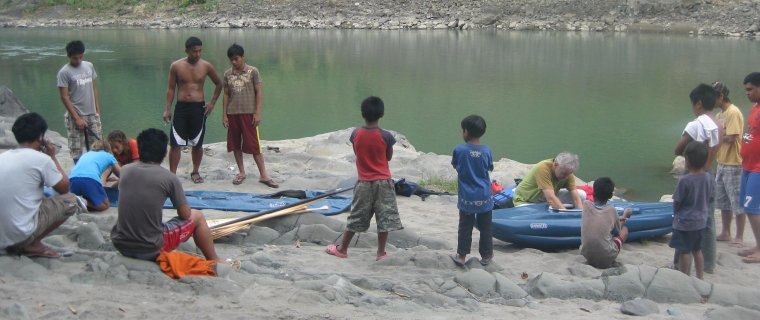
The first rapid just after the village, about white water level 2, took us by surprise. The river had actually a lot more water than expected, more than the Ardeche had in Summer last year. The swells were quite large and the Palava and Miriam’s Traveller immediately filled up with water.
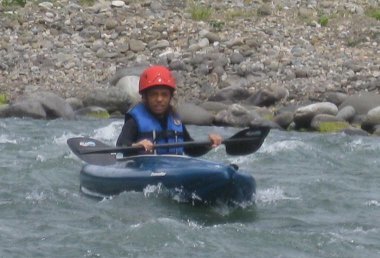
The Palava was around half full, adding approximately 100kg to the weight and became too heavy to manoeuvre properly. A side swell hit us and we turned over thus finding ourselves swimming in deep, quiet water. My first thought was “..amateurs, hopefully the villagers did not see this…”. Miriam made it without problems but had to empty her boat.
She then decided to use the spray cover. Mavic, who was previously sitting in the luggage bag at the centre of the Palava, decided to kneel. I also tied the luggage bag better to the Palava; it had gotten loose and floated away when we capsized.
From then on it went a lot better. At this season this section Chico River is basically a sequence of level 1-3 rapids, each always followed by around 100-400 m of quieter water. There were no dangerous sections although we got out of the boat several times to look at some of the rapids before rafting them. Most of the rapids are caused by big boulders, most of them covered with water but quite shallow so steering around them is advisable with the inflatables. After almost every rapid we had to empty the Palava, which meant going to the river bank, the three of us getting out of the boat, turning it sideways, and back in the boat. It is highly advisable to tie all baggage properly, then it stays in place and one does not have to re-load the boat each time after draining the water out. Miriam gave up on the spraycover after two more rapids because her life jacket is too long and is therefore not designed for kayaking. The first rapid must have had the biggest waves because her Kayak did not fill up anymore afterwards even without spraycover.
Halfway down Miriam also capsized. We had made it a habit to go first with the Palava to check out the rapid as it was Miriam’s first time to go alone in a Kayak. Once down we would signal her, paddle above the head waved sideways meant she can go, paddle waved up and down above the head meant that the rapid is too difficult for her and we would have to either carry or I would kayak her boat down. When the rapid was easy we gave the sign from the boat. At more difficult rapids we went to the shore, got out of the boat and secured her. The rapid where she capsized had a lot of swells coming from the side and one must have hit her sideways. She said later she did not know what happened, only realized that all of a sudden she was swimming in the water next to her boat.
In one rapid a lot of logs had accumulated and were stuck on boulders sticking out into the main stream. Not wanting to test whether the inflatables are more durable than the logs we decided to let the empty boats down on ropes, carrying on the river bank would have been very difficult because it consisted of huge boulders. It took a while to lead the empty boats along the side of the stream, half walking half floating because of the big rocks on the river bed, but it was easily done.
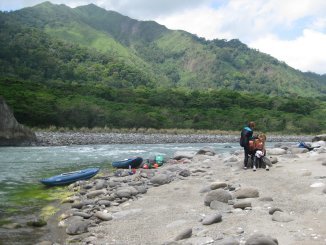
We did several drink, snack and swim stops. The kids heated up in the wet suits quite quickly and often had the urge to dip in the water. The scenery is beautiful. The only downside is the lack of a sandy river bank for a comfortable stop and swimming since all the stones in the river bed are quite big.
In the last major rapid before Lumber village we capsized again. I had just given Miriam the “go ahead” signal with the paddle, still having it high in the air, when we hit an eddy, and all went swimming. At the beginning of the rapid we had agreed on a rest after it and I had jokingly said “we will be swimming anyway”.
At Lumber villages we decided to call it a day. My back had held up OK but I was feeling the strain by then. It also appeared that the most interesting part of the river was over by then, the mountains opened up and the valley became much wider. Our driver was already waiting for us.
A beautiful river. During the dry season the water is clean and blue. From Naning to Lumber village the scenery often reminded me a bit of sections of the Ardeche in Southern France. Further down, when the valley opens up, the scenery is more similar to the rivers in Northern Italy. We had been on the river for merely 3 hours. We definitely have to come back and do the whole river length.
First Assessment of the Gumotex Traveler versus the Gumotex Palava


And yes, we do need to get a better camera.
